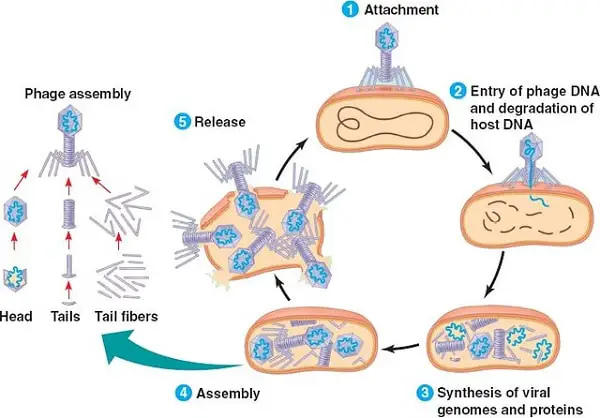A virus undergoes multiplication inside the host cells to produce a number of virions. This occurs as the virus genome takes control over the host cell’s protein synthesis machinery. See the image below for the mechanism.

Of the type of viruses, bacteriophages show two distinct types of reproduction in their life cycle. which are
1. Lytic cycle.
2. Lysogenic cycle.
Lytic vs Lysogenic cycle Differences
| Sl.No | Lytic cycle | Lysogenic cycle |
| 1 | Lysis means breakdown. As the name indicates, the lytic cycle will lead to the destruction of the infected cell. | In lysogeny, the integration of DNA occurs with that of the host occurs. The viral genetic material called prophage transmits into daughter bacterial cells. |
| 2 | The virions formed by free multiplication of the viral genome inside the bacteria. Then they are released by cell destruction. |
In lysogeny, the virus multiplies by the prokaryotic reproduction of bacteria. That is each daughter bacteria formed contains the viral genes from the infected mother cell. From these daughter cells again they can go for a lytic cycle. |
| 3 | Bacteriophages that undergo a lytic cycle are virulent type. Hence, the lytic cycle is a dangerous type | Bacteriophages that undergo the lysogenic phase are non-virulent or temperate. |
| 4 | Host cells undergo lysis. | The host cell does not undergo lysis. |
| 5 | The virus multiplies in a short duration. | Takes time to multiply |
| 6 | The host DNA gets hydrolyzed. | The host DNA is not hydrolyzed. |
| 7 | There is no integration of viral DNA with that of the host | The viral DNA integrates with bacteria DNA. |
| 8 | The symptoms are evident in the lytic cycle. | The symptoms are not evident in the lysogenic cycle. |
| 9 | Genetic recombination of the host DNA does not occur. | Genetic recombination of the host DNA occurs. |
| 10 | The cellular function of the host cell is completely taken under control by the virus gene. | The cellular function of the host is partially controlled by the virus gene. |
| 11 | There is no formation of the prophage. Prophage is the viral DNA integrated into circular bacteria DNA. | The prophage is formed. |
| 12 | The lytic cycle occurs through the following steps. 1. Adsorption 2. Penetration 3. Transcription. 4. Assembly & release | Some phages encode a repressor protein in the bacterial host which inhibits the lytic cycle. In such cases, the lysogenic cycle occurs. The steps include. 1. Adsorption 2. Penetration 3. Transcription. 4. Spontaneous induction 5. Assembly & release |
| 13 | The number of bacteriophages formed is less. | The number of bacteriophages formed is profuse and high. |
The stages of the lytic cycle are as follows
1. Adsorption
Tip of the phages’ tail attached to the cell surface of the host via specific receptor sites. The host which lacks the receptor is resistant to the phage infection. After adsorption, the sheath of the phage becomes short and wide.
2. Penetration
The penetration of phage DNA is mechanical. Binding to the host cells occurs due to electrostatic interactions which are influenced by Mg 2+ and Ca 2+. Enzymes like lysozyme and endolysin protein attack the peptidoglycan of bacteria and digest it. the cell wall is also digested by viral activation of host degradation enzymes. The head and tail remain outside after the penetration of phage DNA.
3. Transcription / Replication and maturation:
This process occurs in several steps. Immediate early delayed early and late
gene products are produced. Immediate early gene transcribe using
RNA polymerase. It codes for nucleases (breaks host DNA) and enzymes (alter bacterial RNA polymerase to transcribe delayed early phage genes).
Delayed early gene codes for polymerases, ligases, phage enzymes
that produce phage DNA constituents like 5- hydroxymethylcytosines (it replaces bacterial cytosine), glycosylating enzymes and enzymes which destroy precursors of cytosine deoxynucleotides. Late gene code for lysozyme, structural components like head, tail and fibers.
Synthesis of host mRNA and thereby the protein formation is stopped.
Host DNA is degraded into small fragments. The nucleoid region of the host is
dispersed. During this process, phage mRNA is produced which codes the production of capsids, virion specific proteins, etc. The time when the number of phages increases is called a rise period.
4. Assembly and release
Formed phage components assemble together to a mature phage and get released by the rupture of the host cell. Time from infection to lysis is called a latent period.
Lysogenic cycle
1. Adsorption: This step shows a similar mechanism of adsorption of the lytic cycle.
2. Penetration: Penetration is also similar in both the reproductive cycles.
After penetration, phages could not be recovered and this period is called an eclipse period (in both cycles).
3. Prophage formation: Phage DNA gets integrated into host DNA is called a prophage. This prophage (behaves as a plasmid) in the host chromosomes acts as a gene. When the host replicates and divides, the prophage replicates along with it and gets transmitted to the daughter cells.
4. Spontaneous induction: The process of separation of prophage from the host chromosome is called spontaneous induction. When the prophage containing host cell is exposed to UV radiation, heat, stress, or some chemicals; the prophage gets excised from the bacterial chromosome. The induction is followed by replication, maturation, assembly and release of the phage as in the lytic cell.
Assembly and release: This step is similar to the assembly and release of phages in the lytic cycle.